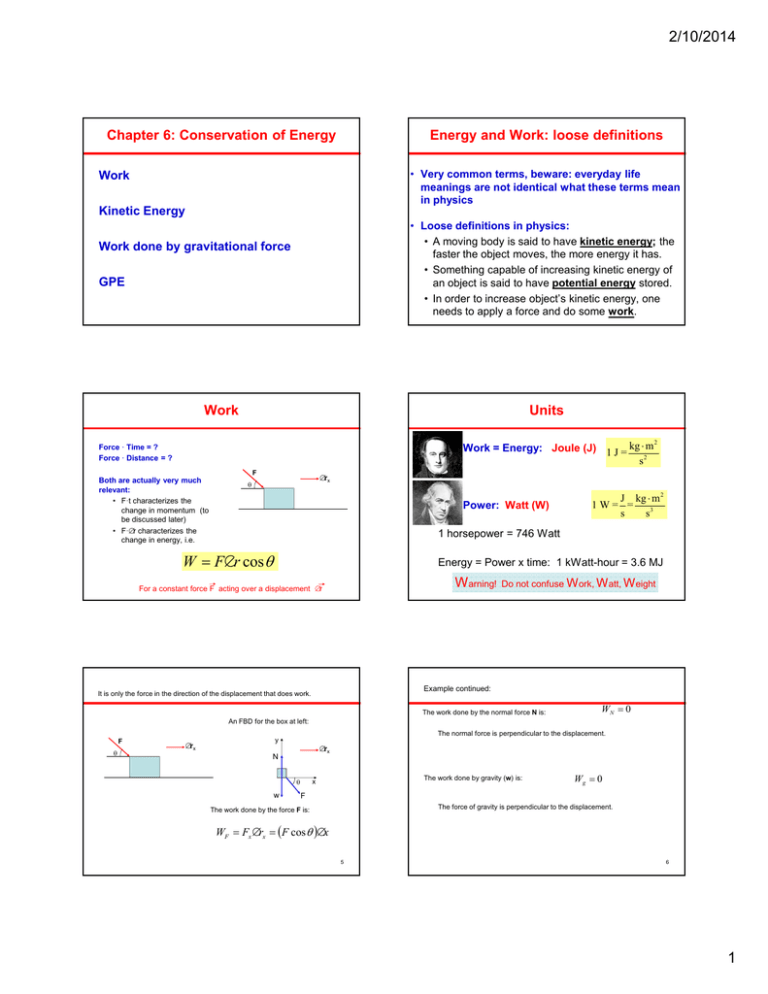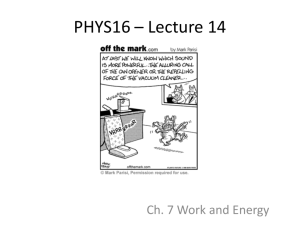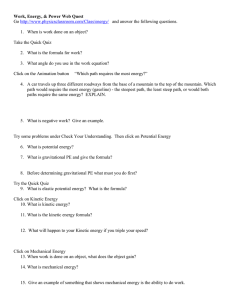2/10/2014 Chapter 6: Conservation of Energy Energy and Work: loose definitions
advertisement

2/10/2014 Chapter 6: Conservation of Energy Energy and Work: loose definitions • Very common terms, beware: everyday life meanings are not identical what these terms mean in physics Work Kinetic Energy • Loose definitions in physics: • A moving body is said to have kinetic energy; the faster the object moves, the more energy it has. • Something capable of increasing kinetic energy of an object is said to have potential energy stored. • In order to increase object’s kinetic energy, one needs to apply a force and do some work. Work done by gravitational force GPE Work Units Work = Energy: Joule (J) 1 J = kg ⋅ m s2 Force · Time = ? Force · Distance = ? F Both are actually very much relevant: • F·t characterizes the change in momentum (to be discussed later) • F·∆r characterizes the change in energy, i.e. 2 ∆rx θ Power: Watt (W) J kg ⋅ m 2 1W= = s s3 1 horsepower = 746 Watt W = F∆r cosθ Energy = Power x time: 1 kWatt-hour = 3.6 MJ W arning! For a constant force F acting over a displacement ∆r Do not confuse W ork, W att, W eight Example continued: It is only the force in the direction of the displacement that does work. The work done by the normal force N is: WN = 0 An FBD for the box at left: The normal force is perpendicular to the displacement. F θ ∆rx y ∆rx N θ w The work done by gravity (w) is: x Wg = 0 F The force of gravity is perpendicular to the displacement. The work done by the force F is: WF = Fx ∆rx = (F cos θ )∆x 5 6 1 2/10/2014 In general, the work done by a force F is defined as The net work done on the box is: W = F∆r cos θ Wnet = WF + WN + Wg = (F cos θ )∆x + 0 + 0 where F is the magnitude of the force, ∆r is the magnitude of the object’s displacement, and θ is the angle between F and ∆r (drawn tail-to-tail). = (F cos θ )∆x 7 8 What did you see? Why do we tell you to memorize this? a) Lot of mechanical problems can’t be solved exactly but we still want to understand part of the problem. b) Because these concepts help understand complex mechanical systems. You can understand why by studying the history a little First, some questions about billiards http://www.youtube.com/watch?v=p_aOWYYnIHo http://comp.uark.edu/~jgeabana/mol_dyn/KinThI.html There are many physical systems with many particles where velocities change a lot. Gottfried Wilhelm Leibnitz (Newton’s competitor) ~ 1680: Sometimes even when velocities change, something stays the same: Total kinetic energy of all the particles didn’t change in gas simulation: N 1 2 K = ∑ mi vi 2 i =1 “Conservation laws” Statement about a physical quantity which doesn’t change with time. Energy, momentum… Kinetic Energy K= 1 2 mv 2 is an object’s translational kinetic energy. This is the energy an object has because of its state of motion. It can be shown that, in general Wnet = ∆K . 12 2 2/10/2014 Example Accelerating free object (const. a!) The extinction of the dinosaurs and the majority of species on Earth in the Cretaceous Period (65 Myr ago) is thought to have been caused by an asteroid striking the Earth near the Yucatan Peninsula. The resulting ejecta caused widespread global climate change. If the mass of the asteroid was 1016 kg (diameter in the range of 4-9 miles) and had a speed of 30.0 km/sec, what was the asteroid’s kinetic energy? 1 d = v0t + at r d r F W = Fd cos θ = Fd = ma ⋅ d r v0 r v0 2 2 ( )( 1 1 K = mv 2 = 1016 kg 30 ×103 m/s 2 2 = 4.5 ×10 24 J v = v0 + at ) 2 Kinetic energy: K= mv 2 2 v − v0 a v − v0 2 at 2 mv 2 mv02 W = ma ⋅ d = ma v0 t + + − = ma v0 = ... = 2 2 2 2 a a This is equivalent to ~109 Megatons of TNT. = K − K0 13 Decelerating free object W = Fd cos θ = − Fd = − ma ⋅ d 1 d = v0t − at 2 Sliding an object along a table W = Fnet d cos θ = Fnet , x d = ma x ⋅ d r F r v0 r d 2 v = v0 − at at 2 mv 2 mv02 W = −ma ⋅ d = −ma v0t − − = K − K0 = ... = 2 2 2 W = ... = Work can be negative, if you act with a force against displacement r d r Fg = mg mv 2 mv02 − 2 2 Work done by gravitational force Wg = Fg d cosθ = −mg∆y ∆r FBD for rising ball: r d ∆y r Fg = mg x w r F r v0 Work can be zero, if the force is normal to displacement Example: A ball is tossed straight up. What is the work done by the force of gravity on the ball as it rises? y a t2 d = vx 0t − x 2 vx = vx 0 − a x t r FN Wg = w∆y cos 180° = − mg∆y Work done by gravity • depends on the change in height only • independent of the path! ∆y 17 3 2/10/2014 Gravitational Potential Energy Part 1 Work done by gravitational force alone (e.g. projectile in free fall) r v Wg = −mg ( y − y0 ) Wg = mv 2 mv02 − (work-KE “theorem”) 2 2 mv 2 mv02 − 2 2 mv 2 mv02 + mgy = + mgy0 = const 2 2 r v0 y Objects have potential energy because of their location (or configuration). r Fg = mg − mg ( y − y0 ) = There are potential energies associated with different (but not all!) forces. Such a force is called a conservative force. y0 20 The change in gravitational potential energy (only near the surface of the Earth) is Wg = −mg∆y Wcons = − ∆U In general Sneak preview: total energy = “potential energy” + KE is conserved Example: What is the change in gravitational potential energy of the box if it is placed on the table? The table is 1.0 m tall and the mass of the box is 1.0 kg. ∆U g = mg∆y where ∆y is the change in the object’s vertical position with respect to some reference point that you are free to choose. First: Choose the reference level at the floor. U = 0 here. ∆U g = mg∆y = mg ( y f − yi ) ( ) = (1.0 kg ) 9.8 m/s 2 (1.0 m − 0 m ) = +9.8 J 21 22 Energy Conservation laws Example continued: Mechanical energy is Now take the reference level (U = 0) to be on top of the table so that yi = −1.0 m and yf = 0.0 m. Whenever nonconservative forces do no work, the mechanical energy of a system is conserved. That is Ei = Ef or ∆K = −∆U. ∆U g = mg∆y = mg ( y f − yi ) ( E = K +U ) = (1 kg ) 9.8 m/s 2 (0.0m − (− 1.0 m )) = +9.8 J The results do not depend on the location of U = 0. 23 24 4 2/10/2014 Example (text problem 6.28): A cart starts from position 4 with v = 15.0 m/s to the left. Find the speed of the cart at positions 1, 2, and 3. Ignore friction. Example continued: E4 = E2 Or use E3=E2 U 4 + K4 = U 2 + K2 1 1 mgy4 + mv42 = mgy2 + mv22 2 2 v2 = v42 + 2 g ( y4 − y2 ) = 18.0 m/s E 4 = E3 E4 = E1 U 4 + K 4 = U 3 + K3 U 4 + K 4 = U1 + K1 1 1 mgy4 + mv42 = mgy3 + mv32 2 2 1 1 mgy4 + mv42 = mgy1 + mv12 2 2 v3 = v42 + 2 g ( y4 − y3 ) = 20.5 m/s Or use E3=E1 E2=E1 v1 = v42 + 2 g ( y4 − y1 ) = 24.8 m/s 25 Example (text problem 6.84): A roller coaster car is about to roll down a track. Ignore friction and air resistance. 26 Example continued: (b) What is the force exerted on the car by the track at the top of the loop? m = 988 kg 40 m FBD for the car: y 20 m Apply Newton’s Second Law: y=0 ∑F (a) At what speed does the car reach the top of the loop? y Ei = E f = − N − w = − mar = −m x U i + Ki = U f + K f N 1 mgyi + 0 = mgy f + mv 2f 2 v f = 2 g ( yi − y f ) = 19.8 m/s N +w=m w N =m v2 r v2 − mg = 2.9 × 104 N r 27 Example continued: v2 r 28 Example continued: (c) From what minimum height above the bottom of the track can the car be released so that it does not lose contact with the track at the top of the loop? What is vmin? v = vmin when N = 0. This means that v2 r v2 w = mg = m min r vmin = gr N +w=m Using conservation of mechanical energy: Ei = E f U i + Ki = U f + K f 1 2 mgyi + 0 = mgy f + mvmin 2 Solve for the starting height v2 yi = y f + min 2g The initial height must be yi = y f + 29 2 vmin gr = 2r + = 2.5r = 25.0 m 2g 2g 30 5





